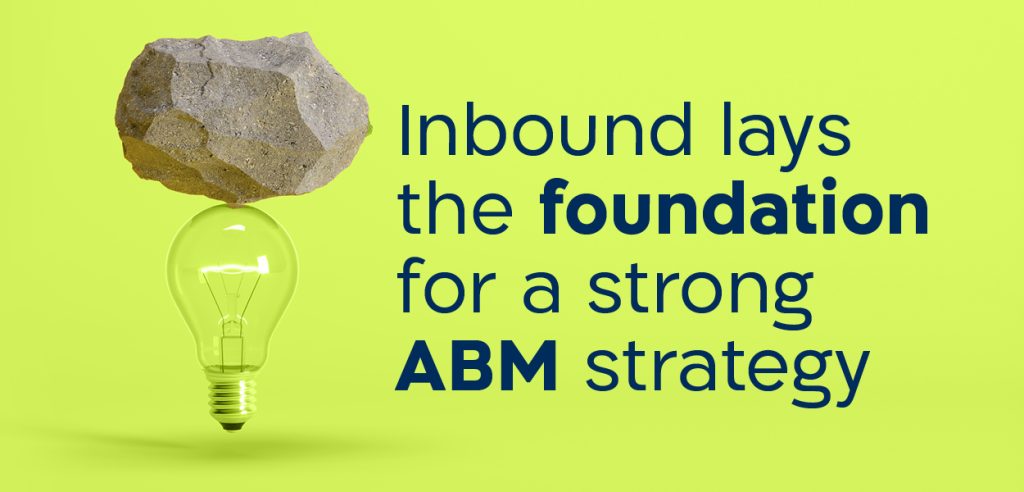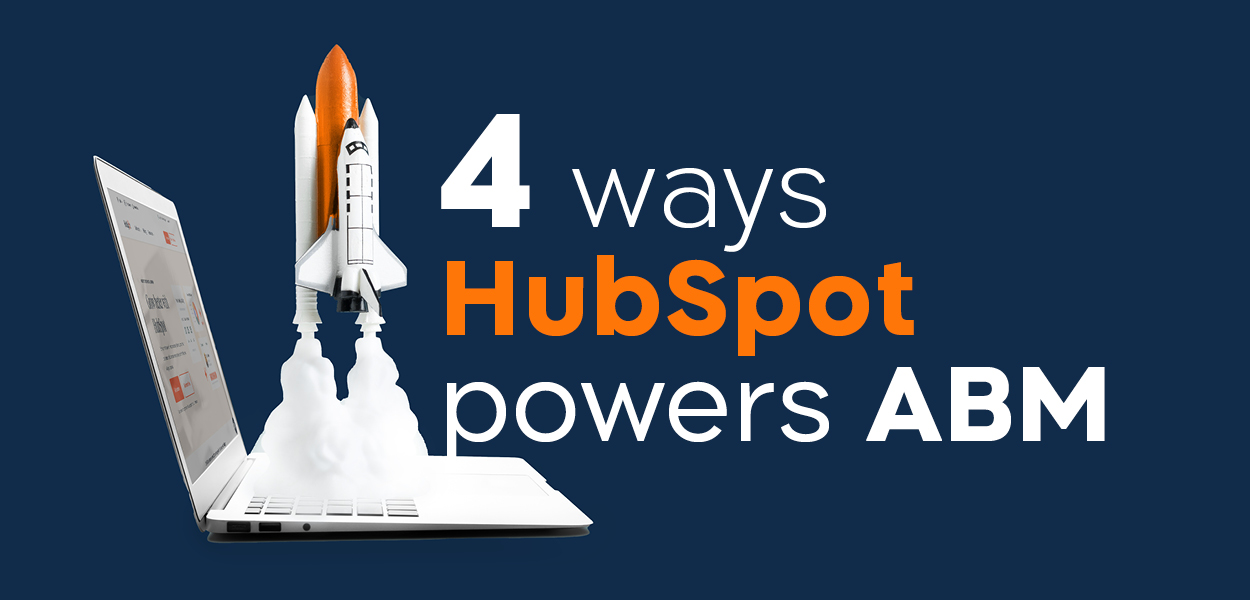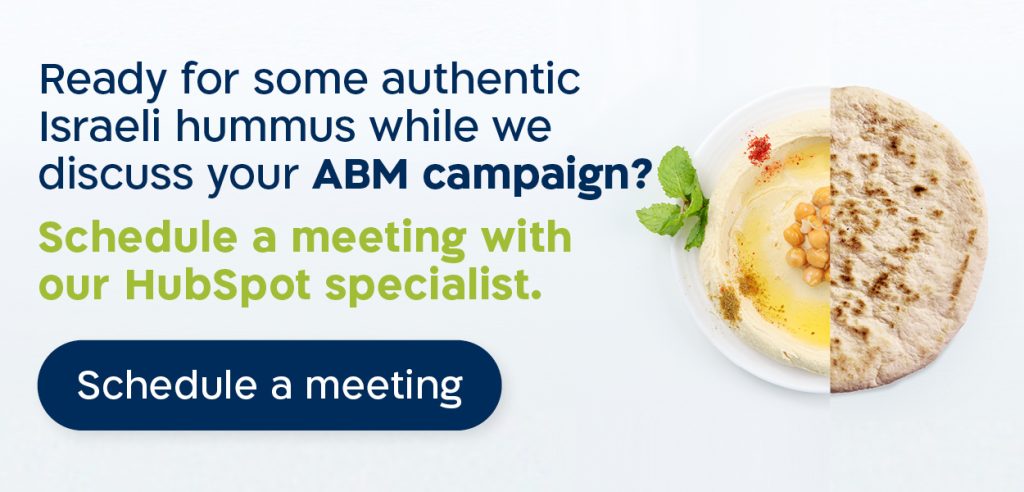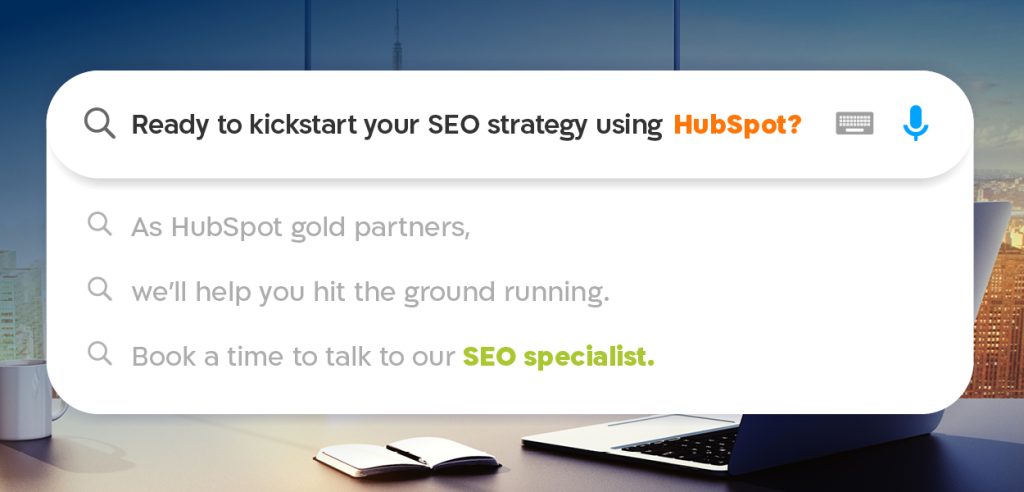Liron Ramot

Liron Ramot Recent Posts
Why HubSpot and ABM go together like hummus and pita?
By
Liron Ramot
, 22/01/2024
Discover the powerful synergy between HubSpot's Inbound Marketing and Account-Based Marketing (ABM) in our blog. Inbound sets the foundation for a robust ABM approach, attracting a broader range of prospects. Learn how HubSpot's ABM tools facilitate quick strategy setup, collaboration, attraction of high-value accounts, and effective tracking.
min read
If you’re a fan of hummus, you’ll know that it goes great with pita. While you can eat them separately, they are quite simply, better together. The one really complements the other. The same can be said of HubSpot’s Inbound Marketing methodology and Account-Based Marketing (ABM).
To make sure we’re all on the same page, let’s start by defining these methodologies:

 1. Set up ABM strategy quickly and smoothly
1. Set up ABM strategy quickly and smoothly

Inbound Marketing
Attracts customers by creating valuable content and experiences tailored to them. It’s about building meaningful relationships with consumers, prospects, and customers.Account-Based Marketing
A B2B strategy in which marketing and sales work together to create personalized buying experiences for a select set of high value companies.
Inbound lays the foundation for a strong ABM strategy
According to HubSpot, inbound marketing helps you attract contacts associated with your target accounts. ABM accelerates the flywheel (the cyclical marketing funnel comprising attract, engage, and delight) so you can win and delight your target accounts by providing a standout customer experience. By using inbound, you’re able to carry out highly-targeted allocation of the most relevant resources to your high-value accounts. As a B2B marketer, by using this combined approach you can attract a broader group of prospects than you would if you were only using one method.Double up and deliver value
Your carefully crafted content has a two-for-one value. You can create and use content that serves both your ABM and inbound strategy. As an example, once you’ve created a personalized case study for a target account, you can also share on your website.Leverage account-based marketing tools
HubSpot’s ABM tool makes it easy to implement ABM and inbound strategies in a complementary way. Its CRM platform connects all of your sales and marketing data and allows enables customer-centric automation and personalization. It makes it easy to use data to segment and target your accounts and marketing automation to nurture your buyers or buying committee and hand over your leads to sales. 1. Set up ABM strategy quickly and smoothly
1. Set up ABM strategy quickly and smoothly
- Use workflow templates to define your ideal customer profiles and identify good-fit target accounts
- Set up default properties to tag accounts and buying roles
- Leverage AI-powered recommendations of target accounts
- Use shared tools that unite your teams around the same data in the same place
- Use the Target Accounts feature to obtain a bird’s eye view of progress across all target accounts
- Use Slack to support high-value target accounts, post KPIs, and share notes
- Personalize content and tailor how you engage with stakeholders within an account
- Use account-level targeting in LinkedIn Ads integration to target companies by account status or tier
- Deepen your relationships over time & build connections with stakeholders within each account
- Use the account overview feature to understand what’s happening at an account level
- Employ out-of-the-box ABM reporting dashboards to get a higher-level view
- Obtain a higher level view using company scoring to identify the highest value accounts and prioritize reachout

Spice up your SEO strategy with HubSpot
By
Liron Ramot
, 12/12/2023
Optimizing your website for search engines is crucial. Explore how HubSpot’s SEO Marketing Software simplifies the process. From SEO recommendations to content strategy creation and seamless integration, HubSpot streamlines your SEO efforts. Leverage its tools to define target audiences, research topics, and organize keywords.
min read
You’ve peppered your website content with all the keywords you want to rank for. Yet your site still isn’t appearing in Google search rankings, not to mention Bing. It may be time to rethink your SEO strategy.
A quick reminder: SEO stands for Search Engine Optimization. It primarily drives two things: rankings and visibility — and it helps you position your brand throughout the entire buyer’s journey. When you plug your keyword into a search engine, it brings up a Search Engine Results Page (SERP). What happens next has a lot to do with how well your site is optimized for SEO.
To ask an existential question: If your company doesn’t rank on the first ten search results, does it even exist in the mind of your potential buyer?


How is your website ranked?
Google’s algorithm changes daily, but as a general rule of thumb, it ranks your website on three main factors: on-page SEO, off-page SEO, and technical SEO.- On-page SEO — covers three key areas:
- High-quality content (the heart of on-page SEO)
- HTML (source code including page titles, headers, meta descriptions, image alt-text, and more),
- and site architecture elements (such as page URLs, internal linking, and more).
- Off-page SEO — social sharing, external linking, and more.
- Technical SEO — structured data, site, speed and mobile readiness.
Don’t procrastinate, automate!
Why waste time, money and manual work when HubSpot SEO Marketing Software does it all for you? It can help you plan your SEO strategy, optimize your content, and measure ROI in three key steps:- Get SEO recommendations to optimize your site- Obtain recommendations ranked in order of priority which show which optimizations will have the biggest impact
- Create an optimized content strategy to build search authority- Obtain topic suggestions based on relevance, competition, and popularity and create high quality content around your core topics
- Integrate your SEO software with HubSpot’s content management tools- Obtain search keyword data, choose canonical URLs, get estimates on which topics will yield organic traffic gains, and track key topics on your dashboard
Get topical!
As the SEO project leader, you need to decide on each page’s target audience, goal, topic, and target keywords and phrases. HubSpot’s SEO tools make it easy to research and organize topics and subtopic keywords based on your company’s areas of expertise, which serve as the foundation for all the content you create for your website. Creating relevant and up-to-date content helps your website get indexed more accurately by search engines such as Google, which analyze keyword phrases in your content, title, meta description, hyperlinks, and more.Key tips to getting started with SEO
- Crawl your website, conduct an SEO audit, and define your site architecture.
- Establish a value proposition for every page and review and edit your content accordingly
- Target your audience for that specific page (if it differs according to market segment, application, or product category)
- Update your URLs, page titles, and meta descriptions.
- Making sure that your keyword/s are included in your URL and are used throughout the page
- Incorporate and optimize relevant visual content
- Add internal and external links
Why use HubSpot for SEO?
If haven’t yet made our case for why HubSpot takes the pain out of SEO and adds the gain, here are a few more good reasons to check it out: You don’t need to be an SEO expert, because its built-in SEO tools are built with marketers in mind. There’s no need to know coding either. HubSpot handles the technicalities, so you can focus on content. Here too, HubSpot has a variety of content planning tools built into the platform. It makes it really easy to connect your marketing assets so you can track the buyer’s journey — from awareness to qualified lead to happy customer.How AI Powers Your Marketing & Sales Engine
By
Liron Ramot
, 03/10/2023
Ready to supercharge your inbound marketing game with AI? Say "Aye!" If you're a HubSpot user looking to boost your content creation and sales processes, we've got something exciting for you. Discover how AI can be your secret weapon! Curious to learn more? Click the link to unveil the full potential of HubSpot's AI tools and start revolutionizing your marketing strategy today.
min read
If you’re already using HubSpot to fuel your inbound marketing strategy and drive sales, it’s time you took AI out for a spin
Constantly writing content to fuel your inbound marketing funnel can be time-consuming and costly. While ChatGPT isn’t going to replace your talented content team anytime soon (if at all), it can prove very useful in helping your team conduct research, generate content ideas, and write basic drafts for your team to finetune — so that you can generate more content, faster. It also helps your sales teams focus on closing deals instead of being bogged down by manual tasks. As a HubSpot user, it’s all your fingertips.Say goodbye to writer’s block
Having trouble generating the volume of content you need? Call on HubSpot’s friendly Content Assistant to create or refine web copy, blogs, articles, emails, and more. Using AI, you can generate ideas, outlines, or paragraphs for your required topics. You can also generate sales emails, titles and meta descriptions for pages and posts, and social posts. Simply answer the prompt, “What’s this social post about?” review the result, and tweak until you’re satisfied the post meets your standards. Not writing in English? Set the target language for the required content. Once a language is set, any generated text will automatically be output in that language.Four ways to tweak existing content
Using the “highlight” command, you can rewrite, expand, summarize, or change the tone of the text you’ve highlighted. It’s quick and efficient. Rewrite - Generates different wording for the highlighted text Expand - Elaborates on the content of the highlighted text Summarize - Condenses the highlighted text Change tone - Rewrites the highlighted text in the selected tone: friendly, professional, witty, heartfelt, or educational Beyond using the highlight command, you can also generate headings, paragraphs, and subsections based on your existing content. Clearly describe the content you require and select the required output. Remember to be very specific, use simple language, and provide examples to clarify the context and tone of your request. If at first you don’t succeed, try, try again. Experiment with different prompts until you get the output you need.Best practices for AI-generated content
- Always proofread and edit all your content before you publish it.
- Maintain your brand's voice and style – your tone of voice must be consistent through all marketing materials.
- It’s not all or nothing — remember to balance your AI-generated content with human-generated content.
- Check, check, and check again. While HubSpot has put security measures in place, content assistant may occasionally generate inaccurate, skewed, inappropriate, or misleading information. Make sure you verify the accuracy of the output's content, particularly any statistics or facts.





















